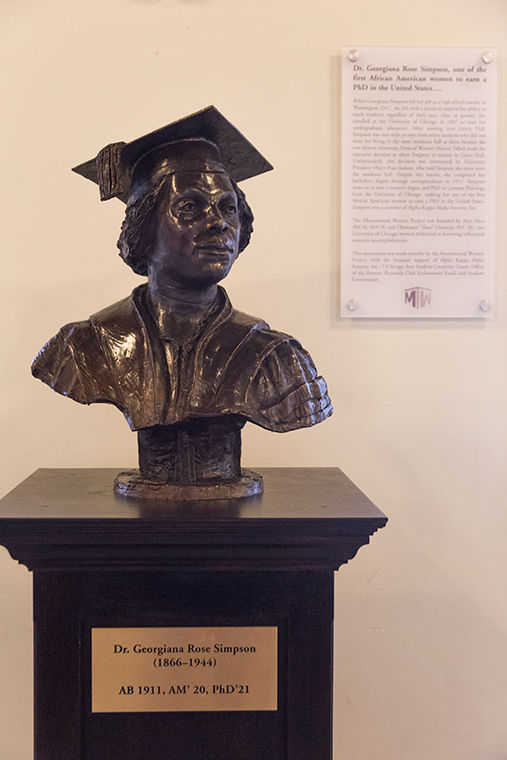Chicago black history discovered through public art
Georgiana Rose Simpson’s bust is the first installment of the Monumental Women Project started by Shae Omonijo and Asya Akca, two political science students at the University of Chicago.
December 11, 2017
Black women are often a footnote in historical stories, said Shae Omonijo, a fourth year political science and human rights major at the University of Chicago.
Omonijo is the co-founder of the Monumental Women Project, which honors influential women in U of C’s history by memorializing them in public art. Omonijo, along with fellow political science student Asya Akca, raised $50,000 over three years to commission a bronze bust of Georgiana Rose Simpson, the first black woman to receive her doctoral degree from the university.
They unveiled the work Nov. 28 at the Reynolds Club, the university’s student center. The bust is placed directly across from a monument of Harry Pratt Judson, the school’s president who said Simpson could not live in the residence halls while studying on campus in 1907 because she was black. The monument’s placement shows that stories are usually much greater than what is told, Omonijo said.
“Oftentimes, you will see the confederate monuments, but you won’t see the slaves next to them,” Omonijo said.
It is important for public art to honor black women, minorities and everyone discriminated against in history, especially in cities like Chicago, Omonijo said.
Preston Jackson, professor emeritus at School of the Art Institute of Chicago, sculpted the Simpson bust and has dedicated his life’s work to creating artwork to represent the black community in Chicago’s art landscape.
When Jackson came into the Chicago art scene in the 1990s, he quickly noticed few black people were included in the industry.
“I have experienced a lot of bigotry being invited to show my work at [exhibitions] when I seemed to be the only black person. That sort of got me on this crusade to change things,” Jackson said. “I wanted to see images that represented people of color.”
Chicago has several other locations and monuments honoring influential and historic black individuals, including the South Side Community Arts Center. The Center allows people of African-American descent to recognize and celebrate their contributions to art and culture in Chicago, said Masequa Myers, the center’s executive director.
Margaret Burroughs was an artist, writer, educator and arts organizer who helped to establish the South Side Community Arts Center in the 1940s and also co-founded the Ebony Museum of Chicago, which is now the DuSable Museum of African American History, 740 E 56th Place.
As community and public art advocates, the South Side Community Arts Center was in a “serious verbal and organized battle to get [Burroughs] recognized” for years, Myers said. Burroughs now has a beach and park monument dedicated to her at 3100 S. Lake Shore Drive on the South Side.
“She is an example of how unfortunately difficult it is to commemorate [a black woman] who is so deserving,” Myers said. “[She was] someone with more than half a century of service to our community.”
Artist Kerry James Marshall unveiled a mural at the Chicago Cultural Center Dec. 4 called “Rush More”—an homage to women who have shaped arts and culture in Chicago—including Gwendolyn Brooks, Oprah Winfrey, Sandra Cisneros and Maggie Daley, according to the Chicago Tribune.
“Can you imagine a little girl walking [by that mural] and thinking ‘Oprah walked these same streets as me and look at where she is now’?” Omonijo said. “That is a very powerful vision to display.”








